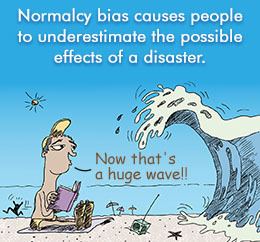 | ||
The normalcy bias
The normalcy bias, or normality bias, is a mental state people enter when facing a disaster. It causes people to underestimate both the possibility of a disaster and its possible effects, because it causes people to have a *bias* to believe that things will always function the way things *normally* function. This may result in situations where people fail to adequately prepare and, on a larger scale, the failure of governments to include the populace in its disaster preparations.
Contents
- The normalcy bias
- Normalcy bias leads to shooting active self protection
- Effects
- Hypothesized cause
- Prevention
- Overreaction
- References
The assumption that is made in the case of the normalcy bias is that since a disaster never has occurred, it never will occur. It can result in the inability of people to cope with a disaster once it occurs. People with a normalcy bias have difficulties reacting to something they have not experienced before. People also tend to interpret warnings in the most optimistic way possible, seizing on any ambiguities to infer a less serious situation.
The opposite of normalcy bias would be overreaction, or "worst-case scenario" bias, in which small deviations from normality are dealt with as signaling an impending catastrophe.
Normalcy bias leads to shooting active self protection
Effects
The normalcy bias often results in unnecessary deaths in disaster situations. The lack of preparation for disasters often leads to inadequate shelter, supplies, and evacuation plans. Even when all these things are in place, individuals with a normalcy bias often refuse to leave their homes.
Normalcy bias can cause people to drastically underestimate the effects of the disaster. Therefore, they think that everything will be all right while information from the radio, television, or neighbors gives them reason to believe there is a risk. The normalcy bias creates a cognitive dissonance that they then must work to eliminate. Some manage to eliminate it by refusing to believe new warnings coming in and refusing to evacuate (maintaining the normalcy bias) while others eliminate the dissonance by escaping the danger. The possibility that some may refuse to evacuate causes significant problems in disaster planning.
Hypothesized cause
The normalcy bias may be caused in part by the way the brain processes new data. Research suggests that even when the brain is calm, it takes 8–10 seconds to process new information. Stress slows the process, and when the brain cannot find an acceptable response to a situation, it fixates on a single and sometimes default solution that may or may not be correct. An evolutionary reason for this response could be that paralysis gives an animal a better chance of surviving an attack; predators are less likely to see prey that is not moving.
Prevention
The negative effects can be combated through the four stages of disaster response:
Overreaction
The opposite of normalcy bias is overreaction bias. Noting the effect regression to the mean, most deviations from normalcy do not lead to catastrophe, despite regular predictions of doomsday. Logically, both underreaction ("normalcy bias") and overreaction ("worst-case thinking") are cognitive flaws.
